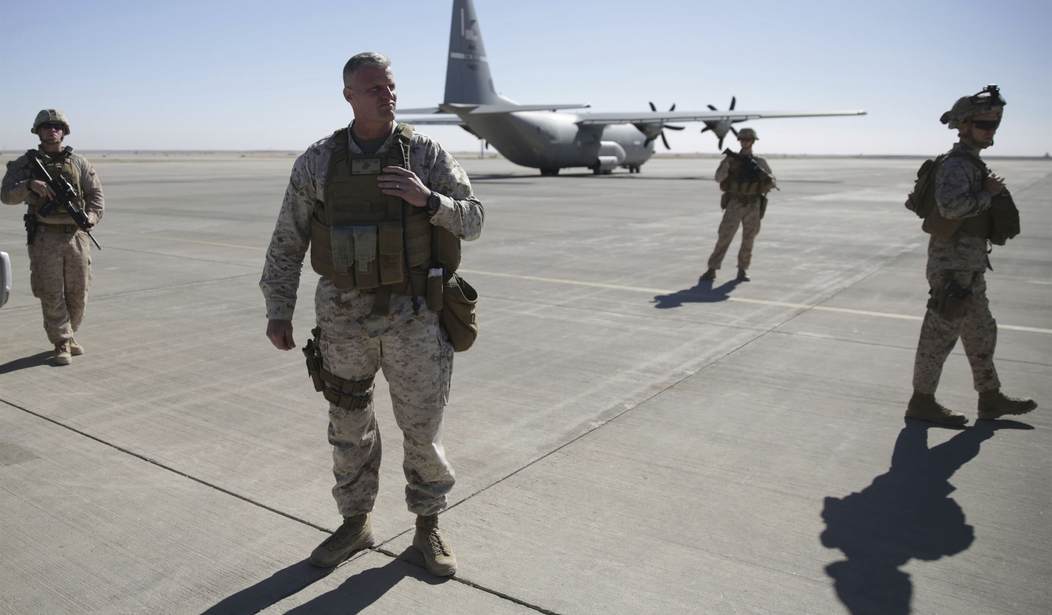In the last half of last year, U.S. armed forces under President Donald Trump’s direction launched 2,000 air strikes against Taliban targets in Afghanistan. That constitutes more raids than in all of 2015 and 2016 combined, the last two years under President Barack Obama’s command.
“The huge spike in airstrikes is the product of new rules of engagement, adopted as part of a strategy that President Trump announced in August,” reports the Washington Post. “U.S. forces can now strike Taliban targets at will, whereas under the Obama administration they were restricted to defending Afghan forces under imminent attack.”
Like the wise change to no longer announcing to our enemies the specific date of our withdrawal, common sense might suggest that the Trump policy of taking the fight directly to that enemy makes a lot more sense than Obama’s completely defensive posture. That is, if one’s goal is to win the war.
If.
But this is no Hollywood war. Sure, the Taliban was long ago toppled from power in Kabul, the capital, but the radical Islamist group has continued to control massive territory across the country. In fact, even the increased U.S. bombing campaign has so far failed to shrink Taliban positions.
“U.S. military leaders acknowledge that the Taliban controls or contests nearly half of Afghanistan’s districts,” the Post informs, “a number that has slowly crept higher through the past year, according to the Special Inspector General for Afghanistan Reconstruction, a U.S. government watchdog.” [Emphasis mine.]
Recommended
That sounds like losing the war. Not winning.
One would also assume that defeating the Taliban is the purpose of said longest-ever U.S. war, now being waged for the 17th year by U.S. forces . . . and a very, very slowly developing Afghan army.
One would be mistaken, however.
The fecklessness of our overall strategy for waging war in Afghanistan is really not disputed. We have no plans to defeat or destroy the Taliban.
Then, what on earth are we still doing there, you ask?
“But whether the new [bombing campaign] strategy is a decisive step toward forcing the Taliban to the negotiating table or just another curve along a seemingly endless road of war,” notes the Post, “depends on whom you ask.”
Two possibilities: First, the heightened bombing may be of no value. Second, it may force the Taliban to the negotiating table and a deal creating a joint power arrangement between the Taliban and the ephemeral Afghan government.
Yes, that’s right: the “good” outcome — the repeatedly stated goal of our current mission — is to force the corrupt, sickening, evil Taliban into a power-sharing role.
We are now spending ‘blood and treasure’ to force the wicked government we somewhat successfully sought to remove from power to come on back and re-take a measure of political control.
“The new strategy presupposes that U.S. and Afghan forces can pound the Taliban so hard that it has no choice but to relinquish its war against the Afghan government and instead join it in some sort of power-sharing agreement,” explains the Post, adding that one American general acknowledged “the Taliban could even be given control of entire provinces in such an agreement.”
Hmm. This goal is worth . . . how many lives?
“We should leave Afghanistan immediately. No more wasted lives. If we have to go back in, we go in hard & quick. Rebuild the US first,” private businessman Donald Trump tweeted in 2013.
Nearing the end of a second decade in Afghanistan, it seems painfully obvious that Trump was (and is) correct. We cannot build a sparkling, new, self-sufficient, freedom-loving Afghan society. If a resurgent Taliban government were to again threaten the USA, that could be addressed, as Trump put it, “hard & quick.”
It is a far more realistic policy, destined to be cheaper in lives and treasure, than nation-building decade after decade — and bombing an enemy you are hoping to turn into a partner in a future Afghan government.
Asked about the increased bombing, Barnett Rubin, an expert on Afghanistan, dismissed its significance: “I’m not skeptical in the sense that they say it’s going great and I say it’s not. It’s more that it doesn’t matter what happens on the battlefield. The Taliban cannot be eliminated. We can say we’ll wait them out, but we can’t. We have the option of leaving, and they don’t. Eventually, one way or another, we’ll take that option.”
“What are we doing there?” Trump argued in a 2012 video blog. “These people hate us. As soon as we leave, it’s all going to blow up anyway. And you say, ‘What are we doing there?’ We’re spending hundreds of billions of dollars, trillions of dollars on this nonsense. . . . What are we doing? We’re a debtor nation. We can’t build our own schools, yet we build schools in Afghanistan.”
Let’s listen to candidate Trump, not President Trump’s advisors. Let’s get out now, before another American soldier is killed.

























Join the conversation as a VIP Member